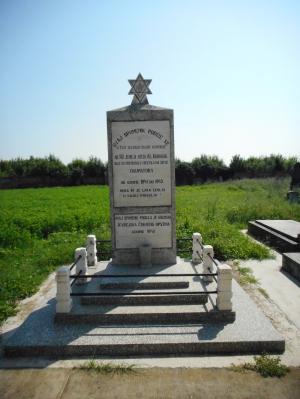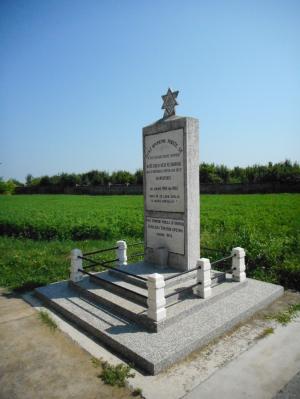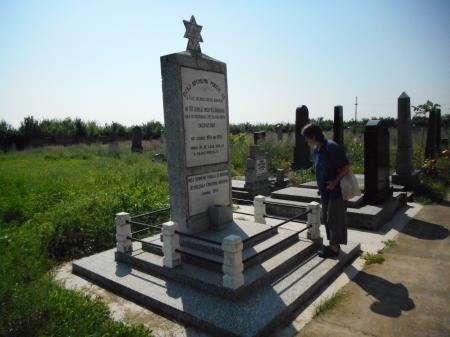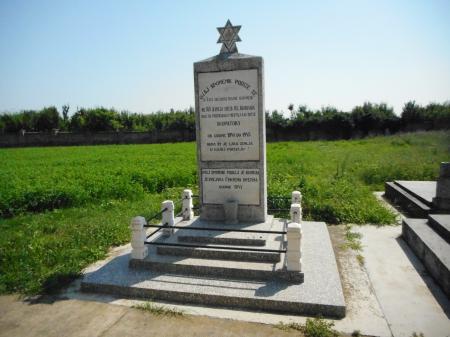Obj. ID: 50015
Jewish Funerary Art Holocaust Memorial in the Jewish Cemetery in Kikinda, Serbia, 1947
To the main object: Jewish cemetery in Kikinda, Serbia

Memorial Name
No official name
Who is Comemmorated?
Victims of the Holocaust from the Kikinda County
Description
The memorial is an upright stele topped with the Magen David and standing on a stepped platform surrounded by a memorial fence comprised of seven short pillars connected by metal. bars. It is made of a combination of grey and white stone. On the stele are two mounted plaques in Serbo-Croatian; the one on top features a commemorative inscription, and the other at the bottom Names the sponsor and when the monument was erected.
Inscriptions
Upper Plaque (Serbo-Croatian)
Ovaj spomenik podiže se
u čast sećanja i trajne uspomene
na 360 Jevreja sreza Vel. Kikindskog
koji su postradali i nestali kao žrtve
okupatora
od godine 1941. do 1945.
Neka im je laka zemlja
u kojoj počivaju!
Translation: This monument is being erected to honor the memory and lasting remembrance of 360 Jews of the Great Kikinda county who suffered and perished as victims of the occupiers from 1941 to 1945. May they rest in peace!
Lower Plaque (Serbo-Croatian)
Ovaj spomenik je podigla Kikindska
jevrejska crkvena opština
godine 1947
Translation: This monument was erected by the Kikinda Jewish Religious Community in 1947
Commissioned by
The Jewish Community of Kikinda
sub-set tree:
Metal
Jews began to settle in the Kikinda district in the first half of the 18th century. The first Jewish religious community was founded in 1800, and the community already had its first synagogue, rabbi, and hazzan within the year. At that time, 198 Jews lived in the town, while the Jewish population numbered approximately 550 at the beginning of the 20th century. The second Kikinda synagogue was built in the town center in 1880 on today's Dositejeva Street. The synagogue was part of the complex that consisted of a school, buildings with apartments, and halls for youth activities. There was also a religious school of Torah study, which had 40 pupils. 45 Kikinda Jews survived the war. The synagogue was first sold in the 1950s and then demolished in 1953.
The monument in the Jewish cemetery was unveiled in 1947. Shortly after the community ceased to exist, and was only renewed in 2003.
Between 1947 and 1948, there were several similar "ad hoc, uncoordinated initiatives that were driven largely by the sense of obligation of the surviving Jews towards their murdered relatives and friends" [Kerenji, p. 209]. As a result of these initiatives, small monuments and plaques were dedicated by communities in Vojvodina, among them Subotica, Sombor, Stara Kanjiža and Senta.
Commemoration ceremonies by this memorial have been held annually on August 14, marking the deportation of Jews from Kikinda in 1941.
Kerenji, Emil, “Jewish Citizens of Socialist Yugoslavia: Politics of Jewish Identity in a Socialist State, 1944–1974,” Ph.D. diss., University of Michigan, 2008, https://deepblue.lib.umich.edu/bitstream/handle/2027.42/60848/ekerenji_1.pdf?sequence=1. June 2020 (accessed February 23, 2022)
"Memorials in Kikinda," Locations (Vojvodina Holocaust Memorials Project), https://www.vhmproject.org/en-US/Locations/Memorials/13 (accessed April 10, 2023). (accessed June 14, 2023)
Rupčić, Tijana, Marko Milošev, Srđan Sivčev, and Vladislav Vujin, Istorija Jevreja u Velikoj Kikindi, (Kikinda: Narodni Muzej Kikinda, 2016)
Ungar, Olga, "Remembering the Victims: Vojvodina Holocaust Memorials," in Jewish Literatures and Cultures in Southeastern Europe: Experiences, Positions, Memories (=Schriften des Centrums für jüdische Studien, vol. 37) eds Renate Hansen-Kokoruš and Olaf Terpitz, pp. 217-236.
Šosberger, Pavle. Jevreji u Vojvodini: Kratak pregled istorije vojvođanskih Jevreja (Novi Sad: Prometej, 1998)












